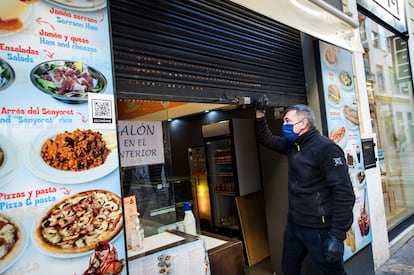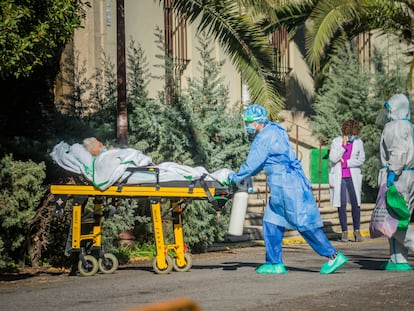Spain headed toward de facto lockdown amid surge in coronavirus cases
Regions across the country have introduced new restrictions that create similar conditions to last spring’s home confinement, while stopping short of shelter-in-place orders

The third wave of the coronavirus pandemic is pushing Spain toward a de facto lockdown, that – while stopping short of the strict home confinement rules introduced last spring during the first wave – greatly restricts social activities and freedom of movement. In response to the rising number of coronavirus cases, Spanish regions have introduced tough new measures, such as the perimetral lockdowns of municipalities and the closure of all food and drink establishments. But there is now debate about whether or not the current state of alarm should be modified to allow regions to apply even stricter restrictions.
Under the state of alarm that was approved last October, there is a nationwide curfew – with the exception of the Canary Islands – from 11pm to 6am, which regional authorities can bring forward or back by an hour. The regions can also seal off their borders, provinces, cities and healthcare areas, so that only essential travel is allowed. But many regional governments want to go further and have called for more leeway to introduce tougher measures.
We are seeing a rise in cases and that makes us want to have more tools to respond. But if the ones we have are applied well, we believe that they will be enoughHealth Minister Salvador Illa
Several regions, for example, want to bring forward the curfew to 8pm, which under the current rules can only begin at 10pm at the earliest. What’s more, the call for earlier curfew times has been sounded by regional authorities of all political stripes: the conservative Popular Party (PP) in Andalusia and the Socialist Party (PSOE) in Valencia. And in Castilla y León, the PP- and Ciudadanos-run regional government has already imposed an 8pm curfew, although the move has since been appealed by the Spanish government. A number of regions, including Andalusia, Castilla y León and Murcia, also want to introduce a full home lockdown, like the one imposed between March and April last year.
But the Spanish government, headed by a center-left coalition of the PSOE and Unidas Podemos, believes the current state of alarm gives the regions enough latitude to contain the pandemic. The government, however, is open to considering earlier curfew times and has agreed to debate the issue on Wednesday at the Inter-Territorial Council of the National Health System (CISNS), which brings together central and regional health officials. But on the question of home confinement, it is firmly opposed. “We are seeing a rise in cases as a result of the Christmas holiday period and that makes us want to have more tools to respond. But if the ones we have are applied well, we believe that they will be enough if we wait 14 days,” said Spanish Health Minister Salvador Illa in a radio interview with SER Catalunya.
Indeed, with the restrictions already in place in some regions, many Spaniards are already under a de facto lockdown, only able to go outside to go to work, to school, for a walk or for exercise. For example, the regional government of Valencia on Tuesday ordered the closure of all food and drink establishments (takeaway service is allowed) and sports facilities. Under the new rules, which come into effect on Thursday, all non-essential retail stores will also have to shut by 6pm.
Authorities in Galicia have also toughened restrictions in 70% of the region. In the affected areas, the hostelry sector is only allowed to serve patrons in outdoor areas and must close by 6pm. The cities of Arteixo (A Coruña province), Viveiro (Lugo) and Xinzo (Ourense) are soon to be under even stricter rules: from Thursday all food and drink establishments and non-essential businesses will be closed.
Regional governments of all political stripes have requested permission to introduce earlier curfew times
But there are great differences in how regions are responding to the surge in coronavirus cases in Spain, where the 14-day cumulative number of cases per 100,000 inhabitants reached 714.21 on Tuesday. In Navarre, for example, which has an incidence rate of 404 cases, all indoor dining areas will be closed from Saturday. Social gatherings will also be limited to just one person from a different household from this date. In Madrid, the 14-day cumulative number of cases per 100,000 inhabitants is 804 – nearly double the figure in Navarre. Despite this, bars and restaurants can remain open (at 50% capacity in indoor areas and 75% in outdoor areas) until 10pm.
In fact, Madrid is one of the regions with the fewest restrictions in Spain, even though the epidemiological situation is worsening. Unlike other PP regional governments, which have shut food and drink establishments, the Madrid executive plans to take no such action. “Don’t count on me to ruin the hostelry sector even more,” said Madrid premier Isabel Díaz Ayuso on Tuesday.
English version by Melissa Kitson.
Tu suscripción se está usando en otro dispositivo
¿Quieres añadir otro usuario a tu suscripción?
Si continúas leyendo en este dispositivo, no se podrá leer en el otro.
FlechaTu suscripción se está usando en otro dispositivo y solo puedes acceder a EL PAÍS desde un dispositivo a la vez.
Si quieres compartir tu cuenta, cambia tu suscripción a la modalidad Premium, así podrás añadir otro usuario. Cada uno accederá con su propia cuenta de email, lo que os permitirá personalizar vuestra experiencia en EL PAÍS.
¿Tienes una suscripción de empresa? Accede aquí para contratar más cuentas.
En el caso de no saber quién está usando tu cuenta, te recomendamos cambiar tu contraseña aquí.
Si decides continuar compartiendo tu cuenta, este mensaje se mostrará en tu dispositivo y en el de la otra persona que está usando tu cuenta de forma indefinida, afectando a tu experiencia de lectura. Puedes consultar aquí los términos y condiciones de la suscripción digital.
More information
Últimas noticias
Welcome to the post-religion era: The idea of Christianity as the absolute truth has become obsolete
‘I thought you would like it’: The risky sexual practice popularized by TV shows and TikTok
The digitalization of tourism: ‘They promise experiences and gave us the worst possible one’
Mexican peso defies uncertainty with forecasts of a new period of stability in 2026
Most viewed
- Sinaloa Cartel war is taking its toll on Los Chapitos
- Reinhard Genzel, Nobel laureate in physics: ‘One-minute videos will never give you the truth’
- Oona Chaplin: ‘I told James Cameron that I was living in a treehouse and starting a permaculture project with a friend’
- Why the price of coffee has skyrocketed: from Brazilian plantations to specialty coffee houses
- Silver prices are going crazy: This is what’s fueling the rally










































